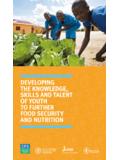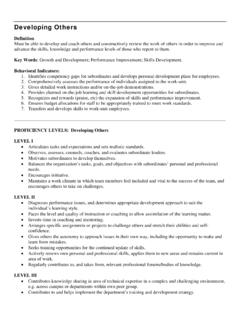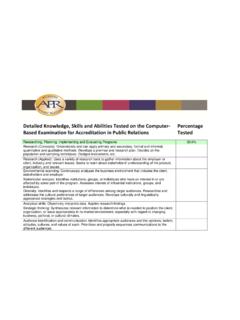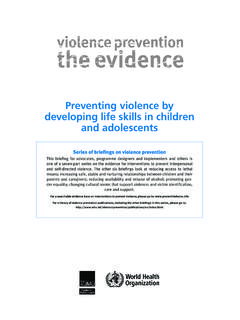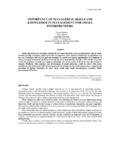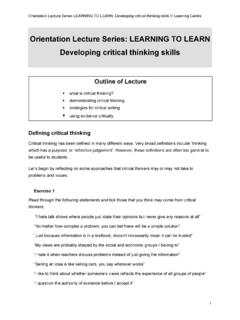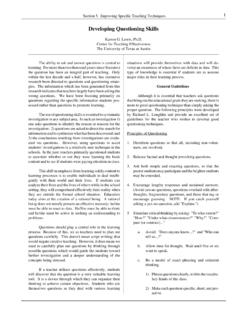Transcription of Knowledge, Skills, and Attitudes Centers for
1 knowledge , skills , and Attitudes Centers for Disease Control (KSAs) for the Public Health and Prevention Preparedness and Response (CDC): Office of Public Health Core Competency Model Preparedness and Response Association of Schools of Public Health September 2012. 0. September 19, 2012. Dear Colleague, Public health professionals traditionally have been trained to assess and address infectious disease outbreaks within their communities. With natural and or manmade disasters occurring more frequently across our nation, however, public health professionals are also facing new challenges that require competencies in public health preparedness and response. The knowledge , skills , and Attitudes (KSAs) to support competency-based training in public health preparedness and response that are described in this report have been defined and vetted by national work groups composed of content experts.
2 The KSAs were selected to enable public health professionals, regardless of work setting, to identify areas of training needed in order to become proficient in the competencies required to address their areas of responsibilities. The KSAs also provide a foundation for a national curriculum to develop core preparedness and response competencies required by public health professionals to address events within a community as well as a region of the nation. Frequently, workers from neighboring communities may need to be engaged in order to protect the health of our communities as we experienced in the NYC area following the 9/11 event or as experienced in Louisiana following Hurricanes Katrina and Isaac. As well, emergencies sometimes require an all hands on deck response within our public health organizations and, thus, we may need to draw from the energy and expertise of employees who may not typically fulfill public health functions.
3 Knowing that agency colleagues in neighboring communities and staff in public health organizations have core competencies in public health preparedness and response required for team efforts is critical in addressing all- hazards events. Audrey R. Gotsch, DrPH, MCHES C. William Keck, MD, MPH Harrison C. Spencer, MD, MPH, Co-chair, ASPH Preparedness and Co-chair, ASPH Preparedness and CPH. Response Core Competency Response Core Competency President and CEO, Association of Development Project Development Project Schools of Public Health Professor and Past Founding Dean, Director, Retired, Akron Health UMDNJ-School of Public Health Department Professor Emeritus, Northeastern Ohio Universities College of Medicine and Pharmacy 1. knowledge , skills , and Attitudes (KSAs). for the Public Health Preparedness and Response Core Competency Model Table of Contents Executive 3.
4 Introduction .. 3. Background: The Core Competency Model .. 4. Figure 1: Public Health Preparedness and Response Core Competency Model v .. 5. Developing the knowledge , skills & Attitudes (KSAs).. 5. Figure 2: KSAs for Public Health Preparedness and Response Core Competencies .. 7. knowledge , skills , and Attitudes .. 8. Figure 3: Domain I Model Leadership .. 8. Figure 4: Domain II Communicate and Manage Information .. 12. Figure 5: Domain 3 Plan for and Improve Practice .. 15. Figure 6: Domain 4 Protect Worker Health and Safety .. 17. Curriculum Development .. 19. Step 1: Conduct a Needs Assessment .. 19. Step 2: Align Domains, Competencies, KSAs, and Learning Objectives .. 19. Figure 7: Aligning Learning Objectives with a Skill to Demonstrate Competency .. 20. Step 3: Select Instructional Strategies.
5 20. Step 4: Create Learning Activities and Resources .. 20. Step 5: Select Assessment Methods .. 21. Step 6: Evaluate Curriculum Development Process and Tools Used .. 21. Acknowledgements .. 21. Appendix A: Workgroup Members by Competency .. 22. Appendix B: KSA Consultative Committee Members .. 24. Appendix C: Glossary of Terms .. 25. Appendix D: References by 26. The development of knowledge , skills , and Attitudes , which align with the Public Health Preparedness and Response Core Competency Model Version , was supported under a cooperative agreement from the Centers for Disease Control and Prevention (CDC) through the Association of Schools of Public Health (ASPH) Grant Number CD300430. The contents of this document are solely the responsibility of the authors and do not necessarily represent the official views of CDC or ASPH.
6 2. Executive Summary The knowledge , skills , and Attitudes (KSAs) for the Public Health Preparedness and Response Core Competency Model, as outlined in this report, provide specific statements of observable and measurable behaviors necessary to master the competencies in the Public Health Preparedness and Response (PHPR) Core Competency Model Version The KSAs were developed and pilot-tested in an iterative process with representatives of the 14 Preparedness and Emergency Response Learning Centers (PERLC) funded by the Centers for Disease Control and Prevention (CDC). The resulting 172 KSAs are recommended for instructors, trainers, evaluators, learners, and other users to both improve and standardize preparedness training and curricula for public health with the ultimate aim of enhancing the public health workforce in protection of the nation's health.
7 In addition, the report includes an overview of curriculum development steps to consider in using the KSAs to create or revise a training curriculum for competency-based education. Introduction Based on the Public Health Preparedness and Response (PHPR) Core Competency Model Version (see description below in Background ), the knowledge , skills and Attitudes (KSAs) for the Public Health Preparedness and Response Core Competency Model represents an important step forward in providing preparedness training for the mid-level public health worker. KSAs offer a means of operationalizing the competencies in the competency model, with learner knowledge described as remembering (cognitive abilities), skills described as doing (psycho-motor abilities), and Attitudes described as feeling (affective abilities).
8 KSAs combine to enable learners to demonstrate behaviors that will help assure effective and confident performance in real-world job situations. The KSAs were drafted and piloted in 2011 and 2012 to enhance the consistency and quality of preparedness training developed for public health workers. They were developed by subject matter experts in preparedness and response from the 14 Preparedness and Emergency Response Learning Centers (PERLC) funded by the Centers for Disease Control and Prevention (CDC). The PERLC represent the current iteration of CDC's Centers for Public Health Preparedness (CPHP) program, the latter having been established in 2000 and closing in August 2010 (see A Brief History and Overview of CDC's Centers for Public Health Preparedness Cooperative Agreement Program by Richmond, et al.)
9 At ). Launched in September 2010, the PERLC. provide competency-based education and training for state, tribal and local public health authorities. See the full issue of Public Health Reports on the CPHP at Under the guidance and facilitation of ASPH and CDC, the PERLC collaborated as a national network to develop KSA statements during their first year of operation. While the PERLC are expected to develop, implement and evaluate training based upon or supported by these KSAs, the ultimate goal is for these KSAs to be used by others for enhancing preparedness training and curricula designed for public health professionals. KSAs offer instructors, trainers, evaluators, learners, and other users guidance for achieving learning objectives in support of improving performance for protecting the nation's health.
10 3. Background: The Core Competency Model The federal 2006 Pandemic and All-Hazards Preparedness Act called for a competency-based training program to train public health practitioners. Between April 2009 and December 2010, ASPH and CDC. developed a competency model to fulfill that mandate, releasing the Public Health Preparedness and Response (PHPR) Core Competency Model Version in December 2010. An article on the initiative is in the pre- publication stage as of the release of this report. That model describes the core competencies that mid-level public health workers, regardless of their employment setting, are expected to demonstrate to assure performance readiness. The model defines a mid- level public health worker as an individual with: * Five years experience with an MPH equivalent or higher degree in public health, or * 10 years experience with a high school diploma, bachelors, or non-public health graduate degree.


